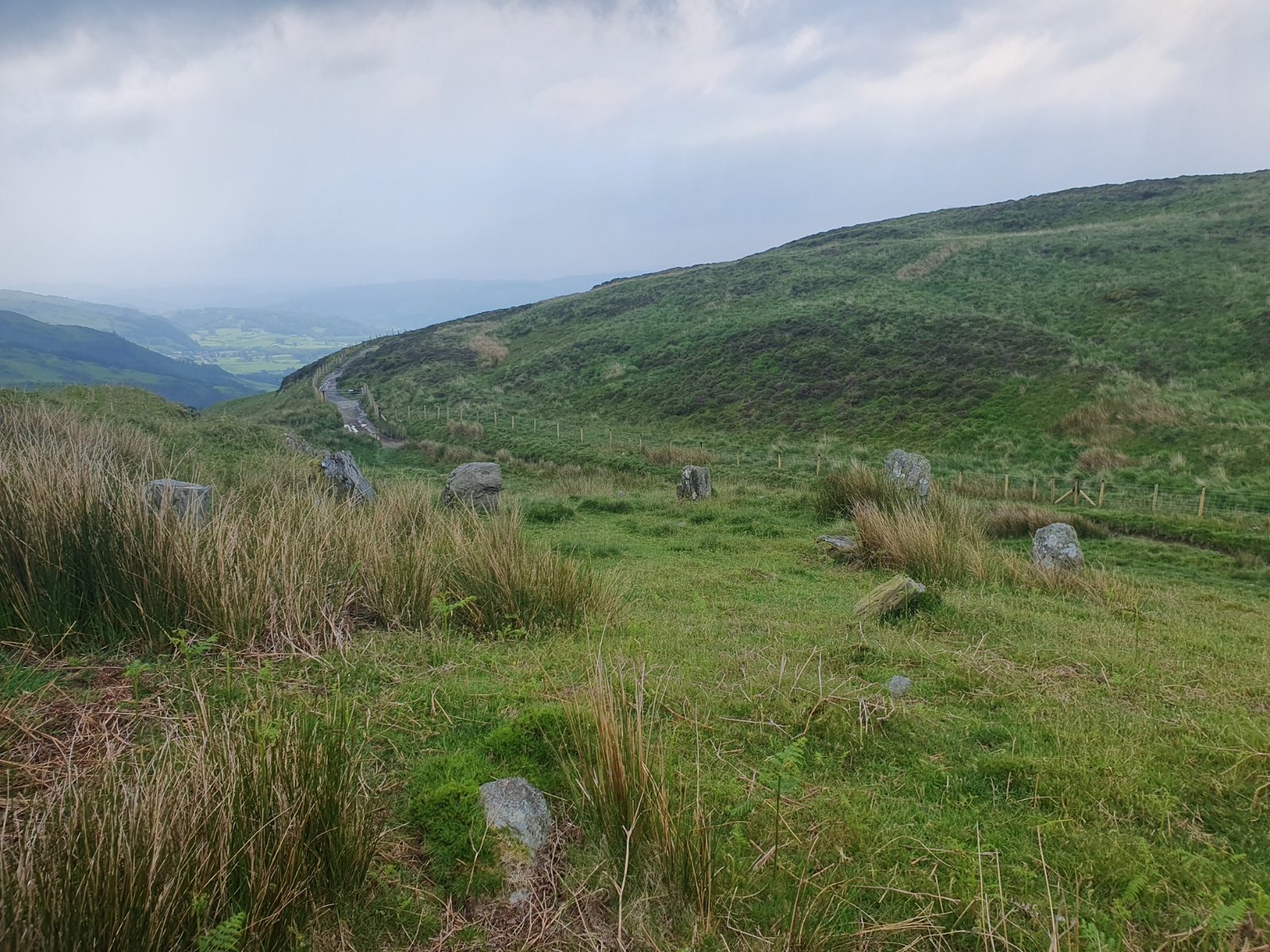Two Mounds and a Circle: “The Irishman’s Church”

Eglwys Gwyddelod
High above the Dyfi Estuary and within the beautiful valley known as Cwm Maethlon is a stone circle known as Eglwys Gwyddelod, which means “the Irishman’s Church”. While it’s entirely possible that the name derives from one of the many people who migrated to Wales from Ireland after the Roman withdrawal it would be more usual to find a hut circle named in that way. We’ll probably never know the truth of it: perhaps the name has become corrupted over time and actually derives from one meaning “the Church of the Trees”. The obvious objection to that name is that we’re well above the treeline here, but temperatures fluctuate over the centuries so that may not always have been the case.
Whatever the truth of it, the siting of the circle is dramatic and seems also to mark a place where a number of paths converge. And the views over the Dyfi estuary are stunning!
The circle is thought to date to the Bronze Age, around 2,300 to 800 BCE, and is small like so many in North Wales, only about 8 metres across, actually elliptical rather than circular, with the stones no more than a metre high.
The path I took up to the stones starts in Cwrt, a hamlet near Pennal, itself between Aberdyfi and Machynlleth. I had read that the road between Pennal and Cwrt is called “Wtra’r Beddau” or “The Lane of Graves”; apparently a battle was fought here between Lancaster and York during the Wars of the Roses (1455 to 1485); sadly the road is said to be paved with the graves of lost soldiers. The hedges alongside the road were of full of wild roses – none of them Lancaster red or York white nor indeed either colour of dragon; all were pink, which I found pleasing.

View from Eglwys Gwyddelod
Pennal also has some interesting history and two mysterious tumuli known as Tomen Las and the North Tomen – the word just means “mound” and that’s certainly true of Toman Las at 32 metres in diameter and 4 metres high. I haven’t yet managed to find the North Tomen. The story goes that Owain Glyndwr raised the mound so that he could stand on it to speak to the people, which seems a little excessive given its size! Coflein, the Welsh online database for national monuments, says that the mound is the motte of a medieval castle, possibly attached to the court of the Princes of Gwynedd, itself removed from the site of the large Roman fort at nearby Cefn Gaer.1 I noticed a rough circle of rushes around the mound, perhaps evidence of a ditch when the castle was still there? But of course none of this proves that the mound wasn’t already there before any castle was built.
Another interesting story connected to the mound is that it marks the grave of one Thomas apGruffydd, a local man who was killed following a swordfight and whose son, Rhys apThomas became an influential supporter of Henry Tudor and may even have been the man who killed Richard III at Bosworth.
An archaeoastronomer, J. R. Hoyle2, notes that the long axis of Eglwys Gwyddelod points directly at Tomen Las and that this, taken with his other research and many calculations, suggests that the Pennal tumuli may have been built thousands of years ago as a lunar observatory. He also noted that to the south-east a cairn on Pen Carreg Gopa, a hill some miles south of Machynlleth, would seem to have the moon skim its edge when rising at its extreme southerly position and adds that Tomen Las, the North Tomen and Pennal church are all exactly placed to have viewed this moonrise at around 2,000 BCE. St Peter’s church in Pennal has a curvilinear churchyard and is reputed to have been built on a former sacred site. Hoyle also notes that the stone ridge on which Eglwys Gwyddelod stands may well have served as an observation platform.

Tomen Las
I don’t believe any archaelogical work has been carried out in the area so this is mostly speculation, but it seems very possible that a large sacred site, maybe including a lunar observatory, once existed here.
You don’t have to travel far in Gwynedd to find fascinating ancient sites and certainly Cwm Maethlon is full of tales: only recently I wrote of the milk-white cow that a farmer in Dyffryn Gwyn managed to extract from the Gwragedd Annwn – “Wives of the Underworld” and which produced excellent milk and never ran dry.3 Nearby, at Llyn Barfog, otherwise known as Bearded Lake, it’s said that Arthur and his horse pulled an afanc or water monster from the lake, and his horse left its hoofprint on a nearby stone called Carn March Arthur, or the stone of Arthur’s horse. But there’s a rival hero: Perdedur, whose full story can be found in the Mabinogi, also aimed to slay the monster. The afanc lived in a nearby cave, attacked people and livestock and caused flooding, not to mention being responsible for the daily slaying of three princes who were then reincarnated overnight, only to fight and lose again. Peredur offered to join them but they were unsure if they could bring him back to life so he set off alone and slayed the afanc, possibly with help from a lady of the court named Angharad Golden-Hand.4
Returning to the Irishman’s Church, older photographs show a block of white quartz in the centre of the circle but this has now disappeared, sadly. The story takes an odd twist here, maybe: a couple of years ago I was walking a section of Sarn Helen betweem LLan Ffestiniog and Bala and had read somewhere that Elen of the Ways may have been buried under one of the mounds alongside it, but it wasn’t obvious which of the many mounds it could be. A few months later I was there again, and this time noticed a block of shining white quartz atop one of the tumuli. It certainly hadn’t been there before! I checked around see when the quartz block was reported as missing from the Irishman’s church and it was several years ago, so – it’s possible but unlikely. I know damage and outright destruction of sacred sites has gone on for centuries, but I can’t help but grieve for the loss. If, however, the block was moved to mark the grave of Elen of the Ways, then I can only smile and wonder if she requested the change!
- Coflein Site Record (no date). Available at: https://coflein.gov.uk/en/site/302965/ (Accessed: 10 June 2024).
- Hoyle, J.R. (2024) ‘Prehistoric Pennal’, (no date)
- The Milk of Kindness | The Goddess Temple of Bala. (n.d.). Retrieved June 20, 2024, from https://goddesstemplebala.co.uk/2024/02/01/the-milk-of-kindness/
- The Episodes of Peredur ap Efrawg: The Addanc | Cei. (n.d.). Retrieved June 20, 2024, from https://tallhwch.wordpress.com/2015/06/20/the-episodes-of-peredur-ap-efrawg-the-addanc/

